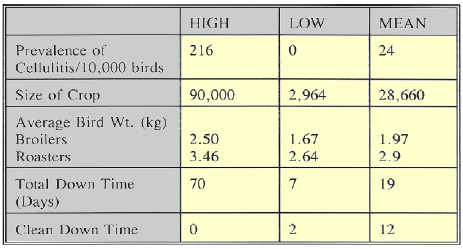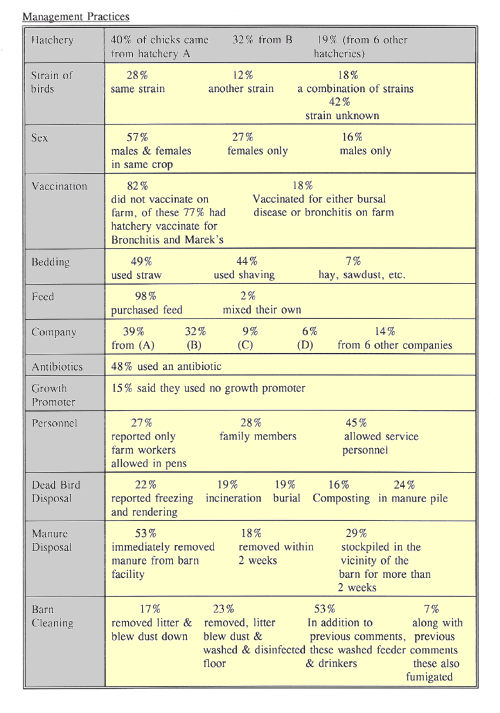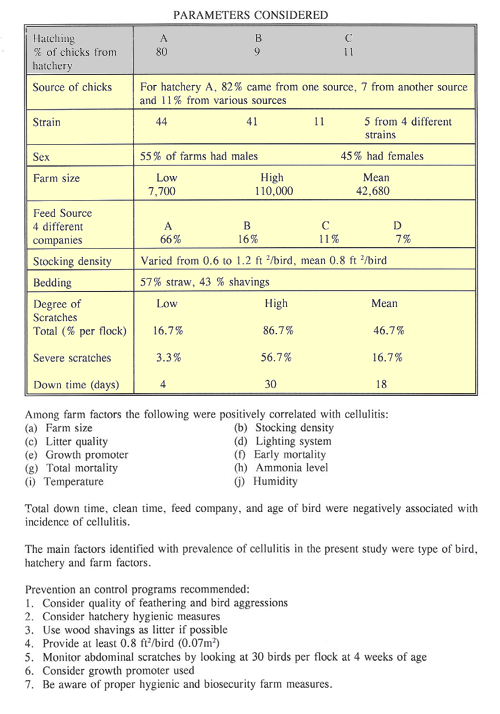



Cellulitis in Broilers
In Canadian Poultry Industry Council's Tech Info 13, Dr John Summers reviews the causes of cellulitis in broilers, its economic impact and how to control the skin condition.The Problem
Cellulitis is caused by an Escherichia coli infection. E. coli infections are very common in broilers with some of the more commonly noted ones being; colibacillosis, colisepticaemia, airsacculitis, swollen head syndrome, synovitis, salpingitis, peritonitis, yolk sac infection and omphalitis, scabby-hip and cellulitis.
Clinical symptoms
Cellulitis is a relatively recently recognized pathological condition of broilers, characterized by discoloration and thickening of the skin and inflammation of the subcutaneous tissues. While not the only bacterium isolated from the lesions, E. coli are by far the most frequent and abundant. Few, if any, clinical signs are observed in affected birds and usually the condition is not detected until the birds are processed.
Extent of the problem
Cellulitis was first reported in Britain in 1984, but since then it has been seen in most broiler producing countries around the world. In 1986, Agriculture Canada designated cellulitis as a condemnation category and reported the condition separately. Condemnation is required when the lesion is generalized or if it shows systemic effects, however, trimming is permitted if the lesion is localized.
The condemnation rate due to cellulitis has been increasing each year and was reported to be 7.5 times greater in 1990 than it was in 1986 (Riddell, 1990). Based on Agriculture Canada data, for the years 1988, 89, 90, cellulitis condemnations averaged 0.12, 0.15 and 0.18%, respectively (Messier, 1993). In a recent report from Agriculture Canada, cellulitis is shown as the number one cause of condemnation in broilers. However, the infection rate for cellulitis would be much higher and a more costly loss to the industry than suggested by the above figures as many birds showing small lesions would be trimmed.
Economic impact
While it is difficult to estimate monetary losses due to cellulitis, as there is the condemnation, as well as the trimming loss, the condemnation loss alone in the USA is estimated to be around $12 million annually, with the full cost estimated to be at least double this figure. While the average condemnation loss is around 0.16% in the USA, there are reports of figures for individual flocks running as high as 6%.
Potential Factors for Controlling or Alleviating Cellulitis
Few studies have investigated the effect of nutrition on E. coli-triggered diseases. It is well known that iron is an essential element for bacterial growth. While free iron in a body is very low due to strong binding by certain physiological molecules, e.g. transferrin, certain E. coli strains have the ability to strongly sequester iron and thus can live under iron-limiting conditions.
Vitamin C and corticosterone have been experimentally documented to be protective against E. coli invasion. However, there is no work to suggest that the incidence of cellulitis is connected with an excess or deficiency of the above nutrients.
Management
Poor litter conditions are more likely to result in an increased incidence of cellulitis due to skin abrasions caused by wet, caked or coarse particles. A genetic effect has also been implemented in cellulitis. This is mainly due to feathering conditions, with slow feathering strains being more prone to skin abrasions. Strains that are more nervous or aggressive would also be expected to experience more skin tears or bruises.
Cellulitis Studies
Although substantial progress has been made in understanding E. coli infections, the emphasis has been placed on studying the organism and its pathological features. There have been several recent studies of cellulitis in broilers but again, these have dealt with characteristics of the E. coli isolated from the lesions and the pathology of the lesions.
There had been no epidemiological study of cellulitis in an attempt to characterize contributing factors such as site, type of building, strain of bird, management, transportation considerations, etc.
Recent Investigations
In order to learn more about the possible factors leading to cellulitis in broilers an epidemiological study was initiated by Dr J.P. Vaillancourt along with his graduate student, Dr A.A.M. Elfadil (1995).
This study was partially funded by the Poultry Industry Centre at Arkell, Ontario. As its objectives, the study was to:
- describe the pathological features of cellulitis lesions
- investigate the possible association between cellulitis and other diseases
- study the role of farm management factors
- monitor strain of bird and stocking density on the incidence of body scratches
- investigate the association between cellulitis and hatchery, farm and environmental factors in separate controlled studies.
Initial study
Seventy flocks, shipped to one processing plant, were studied in the summer of 1992, with the facilities being visited weekly for 7 weeks. An additional study in 1994 looked at 40 flocks and these were studied from hatching to processing. Five condemned carcasses, with non-lacerated lesions of cellulitis, were selected from each flock. These were packed in ice and transported to the OVC pathology department within 12 hours. Each carcass was weighed, internal organs examined for other diseases, and the cellulitis lesions carefully studied. Information regarding the origin of the flock and all condemnation were recorded.
Data from the two separate studies were compared, and since no difference was observed regarding location, colour, size and types of inflammation of the lesions, the data were combined for analysis.
Of the 295 carcasses studied, 87% had one lesion while 13% had two cellulitis lesions. Close to 80% of the lesions were on the abdomen. With regard to degree of inflammation, 68.6% were classified as severe, 26.4% moderate and 5.0% mild. Cellulitis was positively correlated with average bird weight and total percent condemnations.
Study 2
This study involved a mail survey of 248 farms with birds processed in a single plant in Ontario. The survey was conducted in July-August 1993. In the USA, it has been reported that 90% of the flocks examined at the farm had some cellulitis present with an average of around 10 cases per 10,000 birds at the low end to around 32 per 10,000 birds at the high incidence level. Thus, the present survey was undertaken to get an estimate of the incidence of cellulitis at the farm level in Ontario and also to further investigate the association between cellulitis and environment, management and bird factors. Roaster flocks were also included in the study.
A summary of the findings are shown as follows:
Prevalence
Of the 7,389,790 birds processed from the 248 farms, 23,257 carcasses were condemned for cellulitis. This calculates to a prevalence of 31/10,000 birds. By calculation, 36% of the farms were above this figure while 64% were below.
Of the 171 farms from the above survey that returned the questionnaire, the high, low and mean values for various parameters measured were as follows:

Table 2

Association of cellulitis with management factors
Twelve management factors were found to be significantly associated with cellulitis at a P-value of ≤ 0.15%.
Of these, 7 were related to farm hygiene:
- presence of other poultry on site
- presence of other animals on site
- type of litter
- manure removal
- dead bird disposal
- total down time
- other diseases
Two were related to nutrition:
- feed company
- growth promoter
Three were related to type of bird:
- strain
- sex
- weight
Male and mixed flocks were 7.9 and 3.7 times respectively, more likely to experience cellulitis than female flock alone.
Crops grown or feed originating from company A or B were 4.5 and 4.4 times, respectively, more likely to experience cellulitis than those grown on feeds from other companies.
Crops with zinc bacitracin were 9.6 times more likely to experience cellulitis than crops where no growth promoter was used.
Crops grown on straw were 2.8 times more likely to experience cellulitis than those grown on shavings.
Study 3
In a further study during May-June 1994, the correlation between abdominal skin scratches and stocking density, strain, feathering, body weight and abdominal circumference were investigated in a clinical trial conducted at the Poultry Research Station at Arkell.
Two different strains of 480 day-old male broilers were assigned to 4 groups as follows:
- high density (0.08m2 /bird), strain A
- high density (0.08m2 /bird), strain B
- normal density (0.14m2 /bird), strain A
- normal density (0.14m2 /bird), strain B
Birds were grown to 42 days of age on wood shavings and a 24 hour lighting program employed. All birds were examined for body scratches at 28, 35 and 42 days of age. Only the 35-day results can be classified as a double blind experiment.
Overall prevalence of scratches at 28, 35, and 42 days of age was 45, 69 and 57%, respectively, whereas the overall prevalence of severe scratches at 35 and 42 days of age was 39 and 21%, respectively. Severe scratches were more prevalent with strain A, and birds kept under high density conditions. Poor feathering was also associated with severe scratches at 35 days of age. No association was observed between scratches and body weight or abdominal circumference.
Study 4
In a final study the association between cellulitis and hatchery, farm and processing factors were studied. Forty-four flocks of broilers from 24 farms were followed from hatching to processing.
The incidence of cellulitis was significantly associated with hatchery, strain of bird, farm size, type of litter, lighting system, down times, prevalence of abdominal scratches, other E. coli-related conditions, ascites and leg problems.
Bacteriological findings
Lactose-fermenting E. coli were the predominant bacteria isolated from 84% of the litter samples and 80% of the cellulitis lesions.
Hatchery and strain
Of the 24 farms included in the detailed study, 80% obtained chicks from hatchery A, 9% from hatchery B and 11% from hatchery C. The three hatcheries obtained their eggs from 3 sources.
Hatchery A obtained 82% of their eggs from source A, 7% from source B; information for the remaining 11% was not available.
Four strains of birds were provided; 44% from strain A, 41% from strain B, 11% from strain C and 5% from various strains D. (55% of the farms raised males and 45% females.)

Among farm factors the following were positively correlated with cellulitis:
- Farm size
- Stocking density
- Litter quality
- Lighting system
- Growth promoter
- Early mortality
- Total mortality
- Ammonia level
- Temperature
- Humidity
Total downtime, clean time, feed company and age of bird were negatively associated with incidence of cellulitis.
The main factors identified with prevalence of cellulitis in the present study were type of bird, hatchery and farm factors.
Prevention and control programmes recommended:
- Consider quality of feathering and bird aggressions
- Consider hatchery hygienic measures
- Use wood shavings as litter if possible
- Provide at least 0.07 m2/bird (0.8 ft2/bird)
- Monitor abdominal scratches by looking at 30 birds per flock at 4 weeks of age
- Consider growth promoter used
- Be aware of proper hygienic and biosecurity farm measures.
Conclusions
While the above studies have provided some very important and practical information on the incidence and factors contributing to the occurrence of cellulitis, it is apparent that the condition is largely management-oriented.
While cellulitis is largely the result of an E. coli infection, three conditions must be present before the condition appears: firstly, there must be a break in the skin; secondly, the appropriate bacteria must be present and thirdly, the lesion must be unhealed at the time of processing. Thus the main factor is the scratch or bruise on the bird. Many factors can lead to an increase of bruising or skin tears in a pen and these are mainly under the control of the farm manager, through the type of building and equipment employed and the care he takes in ensuring an optimum bird environment.
Most other contributing factors are secondary in nature and while being implemented, from time to time, can only be considered as having a small or insignificant influence on the incidence of cellulitis in a flock.
While the above studies have dealt solely with the incidence of cellulitis as measured by condemnation level at the processing plant, the increased degree of trimming that takes place with cellulitis infected, non-condemned birds, is a major concern to the processor and thus the whole industry.
References
Riddell C., 1990. Clinical observations on E. coli infections in poultry in Saskatchewan. 62nd Northeastern conference on Avian Diseases, Guelph, Ontario.
Messier S., S. Quessy, Y. Robinson, L.A. Devriese and J. Hommez, 1993. Focal dermatitis and cellulitis in broiler chickens. Bacteriological and Pathological Findings. Avian Diseases, 37: 839-844.
Elfadil A. A.M. 1995. An epidemiologic study of the cellulitis in broiler chickens in Southern Ontario. Phd Thesis. University of Guelph.








